| Production tool | Peer reviewed |
Cite as: Campler M, Pairis-Garcia M, Stalder KJ, et al. Rubber mat placement in a farrowing and lactation facility: Tips and techniques. J Swine Health Prod. 2016;24(3):142–146.
Also available as a PDF.
SummarySow lameness may result in severe economic consequences to the producer, as lameness has been associated with increases in involuntary culling, poor reproductive performance, and suboptimal sow longevity. Lameness prevalence and severity are impacted by facility design, with a particular focus on hard concrete surfaces. Use of rubber mats has been previously investigated for its ability to increase sow comfort, prevent lameness development, and mitigate lameness severity. However, limited recommendations or guidelines are available to producers and veterinarians to successfully implement on-farm mat use. This production tool provides guidelines and techniques for selecting, installing, and maintaining rubber mats in farrowing stalls for multiparous sows. | ResumenLa cojera de las hembras puede resultar en consecuencias económicas importantes para el productor, ya que la cojera se ha relacionado con el incremento de sacrificios involuntarios, pobre desempeño reproductivo, y longevidad subóptima de la hembra. La prevalencia y severidad de la cojera son influidos por el diseño de las instalaciones, con un enfoque particular en superficies de concreto duras. El uso de tapetes de hule ha sido previamente investigado por su capacidad de incrementar la comodidad de las hembras, prevenir el desarrollo de cojera y mitigar la severidad de la cojera. Sin embargo, hay limitadas recomendaciones o normas disponibles para que los productores y veterinarios implementen exitosamente el uso de tapetes en granjas. Esta herramienta de producción provee normas y técnicas para seleccionar, instalar, y mantener tapetes de hule en jaulas de maternidad para hembras multíparas. | ResuméLes boiteries chez la truie peuvent avoir de graves conséquences économiques pour le producteur, étant donné que la boiterie a été associée avec une augmentation des réformes involontaires, de mauvaises performances de reproduction, et une longévité sous-optimale des truies. La prévalence et la sévérité des boiteries sont influencées par le design des installations, avec une emphase particulière sur les surfaces dures en béton. L’utilisation de tapis en caoutchouc a été étudiée antérieurement pour sa capacité à augmenter le confort des truies, à prévenir l’apparition de boiterie, et à diminuer la sévérité de la boiterie. Toutefois, des recommandations ou directives limitées sont disponibles aux producteurs et vétérinaires pour implémenter de manière efficace l’utilisation des tapis à la ferme. Le présent outil fournit des directives et des techniques pour sélectionner, installer, et assurer la maintenance de tapis de caoutchouc dans des cages de mise-bas pour les truies multipares. |
Keywords: swine, lameness, rubber mats, on-farm, stall
Search the AASV web site
for pages with similar keywords.
Received: August 25, 2015
Accepted: January 5, 2016
After reproductive failure, sow lameness is the second most common reason for involuntary sow culling in the United States.1 Feet and leg problems have been associated with several factors that result in premature culling, including poor reproductive performance, poor farrowing performance, and suboptimal sow longevity.2 With an estimated 15% sow culling rate due to lameness, annual industry gilt replacement costs have been estimated at $23 million per year, emphasizing that the economic impact must not be underestimated. Although lameness is considered a sow welfare concern and has economic impacts for the industry, few practical on-farm solutions have been developed.
Sow lameness is often a multifactorial problem that can be difficult to prevent and, in turn, to manage. Environmental conditions may play a critical role in lameness severity and prevalence, as both concrete flooring and slats increase the risk of sow lameness.3,4 These facility conditions may also increase injury risk due to slick flooring, thus resulting in additional lameness. Several other conditions can result in a sow becoming lame, including neurological deficits, trauma, osteochondrosis, arthritis, metabolic disorders, and infectious disease.5-7 Managing pain as a byproduct of lameness can be conducted either through pharmaceutical intervention (ie, administration of a nonsteroidal anti-inflammatory drug [NSAID]) or a facility adaptation that provides a more comfortable and accommodating environment. The use of rubber mats may provide a solution that reduces lameness occurrence or severity by providing a softer resting area. Rubber mats have several advantages for on-farm use; for example, they are re-useable and easy to clean and can be utilized in pit-system barns with minimal manure buildup.8,9
Limited research has been conducted on utilizing rubber mats during either gestation or lactation to reduce lameness and injuries. Only a few studies have demonstrated the benefits of rubber-mat use, which include decreased lameness and lesions8-10 and decreased development and healing time of shoulder ulcers.11-13 However, negative effects of rubber mats have also been demonstrated, for example, a higher incidence of piglet lesions14,15 and decreased sow comfort if hard rubber mats are used.16 To date, no study has yet identified the optimal rubber mat or provided any consensus on guidelines for successful use and management of rubber mats in a sow facility.
Therefore, the objective of this production tool was to provide additional information, guidelines, and techniques for selecting, installing, and maintaining rubber mats in unidirectional farrowing stalls for multiparous sows.
Choosing the right mat
The variation in rubber mats available for purchase can make selecting an appropriate mat for use in a stalled system difficult. However, when introducing mats into a sow facility, a few key mat variables must be considered. Primarily, the rubber mat has to be thick enough to provide sow comfort without causing injury and be able to withstand sow and piglet manipulation over an extended period of time. This is especially important when placing mats in farrowing stalls, as sows are highly motivated to root and manipulate objects just prior to farrowing.17,18 Damage to the rubber mat may result in reduced sow comfort, and rubber mat fragments may clog and damage a pit system (Figure 1). Secondly, mats should allow for fecal matter and urine to pass through into the pit system without excessive manure build-up or additional manure-scraping requirements. In addition, the rubber mat should be strong enough and have the integrity to be reused multiple times. For this production tool, 25 perforated boar mats by FarmerBoy Ag (Meyerstown, Pennsylvania) were placed in a commercial sow facility (price: $78.08 per mat [all values provided in US dollars]; width × length × thickness, 99 × 150 × 1.9 cm respectively; perforation size, 1.4 cm). Mats were placed in farrowing stalls and were used through four lactation cycles over a 4-month period. During this time period, mats were exposed to sow and piglet manipulation, staff handling, and power washing and disinfection, with minimal to no signs of damage. This mat was selected after previous experience (unpublished data) with a perforated rubber mat (heavy-duty rubber mat, Farmtek, Dyersville, Iowa; price $47.95; width × length × thickness, 99 × 150 × 1.4 cm respectively; perforation size, 2.2 cm) that showed excessive tearing and fragmenting during one lactation cycle. By 10 to 14 days post placement of the 30 Farmtek rubber mats, at least 30% to 50% of each mat was torn or severely damaged (ie, fragmented; Figure 1) due to normal wear and oral manipulation by the sow and piglets. Thus, all mats were consequently removed from the stalls. The difference in durability between these two mats suggests that the rubber-mat thickness of choice should be at least 1.9 cm to withstand the daily postural adjustments and manipulations of the sow. It should be noted that use of rubber mats should take into consideration environmental conditions, as mats may prevent sows from cooling down during hot and humid summer months.8
Figure 1: A 99 × 150 × 1.4-cm heavy-duty rubber mat damaged by the sow during the day prior to farrowing. Note the different sizes of fragments (7.5 to 25 cm) as well as the damaged area in the rubber mat on the right (approximately 25 × 75 cm).
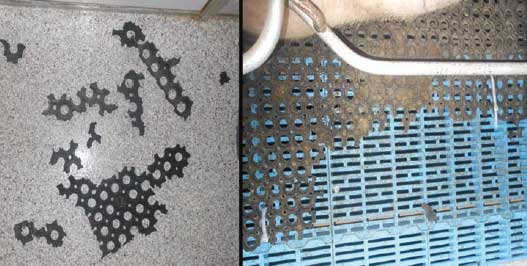
Different rubber mats and thicknesses have been tested out in various other studies8,11-13,15 (ie, 1.27 cm, 0.5 cm, 3.8 cm, 1.8 cm, and 3.0 cm, respectively), but no conclusions on either optimal thickness or material composition for rubber mats in farrowing stalls have been presented. As this production tool was based solely on mat performance and application of two mats in a production setting, further research evaluating additional mats and mat composition is needed.
Cost and management
The rubber mat should be cost efficient, based on the farm’s input and output costs, and require little additional labor. Inputs to be used include the cost of the rubber mat, the zip ties, and the labor needed for installation. One output could be monitoring pre-weaning mortality during lactation. Work published by Grandjot19 reported that lame sows had a 14.6% greater pre-weaning piglet mortality rate than non-lame sows. Hence, if the average litter size is 13, this translates into a loss of 1.9 piglets per litter. Assuming that rubber mats would have a positive effect on reducing pre-weaning piglet mortality, an increase of 1.9 weaned piglets per litter could theoretically be considered increased output. Furthermore, assuming a market value of $40 per weaned pig, two extra weaned pigs per litter would not only cover the initial purchase cost of the FarmerBoy rubber mat ($78.08), but would also provide a rubber mat for up to five or six new litters before replacement is needed. A mat can successfully be placed and zip-tied down in less than 5 minutes prior to moving the sow into the farrowing stall and can be pre-cut to accommodate farrowing-stall dimensions (Figure 2). Pre-cut mats can easily be stored on a pallet close to the farrowing room and be moved and put in place by one person without excessive effort or time. After each lactation cycle, rubber mats can be removed by simply cutting the zip-ties and lifting the mat out of the stall. It is highly recommended that mats be cleaned after each use utilizing both a pressure washer and disinfectant. If mats deteriorate or become damaged, proper disposal of the mat is important, and disposal fees may need to be taken into account.
Figure 2: Cutting a perforated rubber boar mat to the dimensions 99 × 150 × 1.9 cm for placement in a farrowing-lactation stall. The mat should be placed so that the short side faces the back of the farrowing-lactation stall, starting just below the cross bar, and extending forward to include the shoulder of the sow.
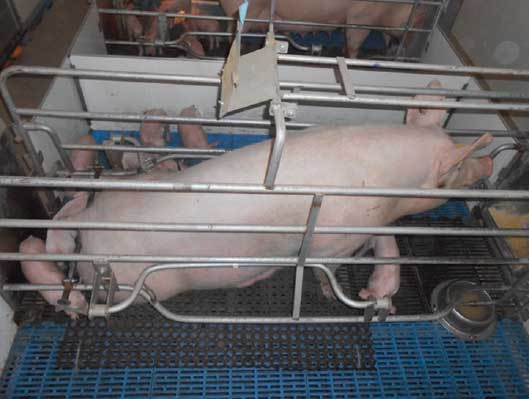
Mat placement and installation
Mat placement is crucial. An incorrectly placed mat may result in an uneven resting surface and increased manure build up (Figure 3). The placement or pre-cutting of the mat may need to be adjusted depending on the specific stall measurements, but the key is to ensure that the mat is wide enough to accommodate the sow’s entire body in recumbency and is positioned in a way to minimize manure build-up at the posterior end of the stall.
Figure 3: Proper placement of rubber mat in a farrowing-lactation stall. Note how the mat ends at the cross bar to allow manure to drop onto the slatted flooring rather than onto the rubber mat.

It has been shown that when rubber mats are placed only under the hind quarters of the sow, occurrence of shoulder ulcers is much lower than when sows lie on bare concrete (Figure 3).11 However, little evidence exists that placing the rubber mat under the shoulder increases the risk of shoulder ulcer development, compared to having the sow lie on bare concrete. It is therefore arguable that placing the mat at shoulder level is better, as all four legs of the sow have access to the mat simultaneously. As lameness can result from either front or hind limb injury, support should be provided for all legs. The assumption that it is best to place mats at shoulder level is strengthened by the evidence that lame sows are approximately 16 times as likely as non-lame sows to develop shoulder ulcers,20 and the fact that existing shoulder ulcers heal faster in sows housed on rubber mats12 further strengthens this assumption. Mats that accommodate only the hindquarters also create a surface ridge that may be less comfortable than either full-mat placement or no mat at all. This ridge might cause lesions in sows provided with rubber mats or may be abrasive to the skin when the recumbent sow is shifting position, especially between nursing bouts. Perforated rubber mats do reduce manure build-up, but manure build-up may still occur, as sow length and defecation patterns play a critical role.
Maintaining a consistent rubber-mat placement requires that the four corners of the mat be fastened to the stall floor. This may be achieved by threading extra-heavy-duty zip ties (61-cm, 79-kg tensile strength; Cable Ties Plus Inc, Duxbury, Massachusetts) through the perforations in the rubber mat and through the slatted floor. Zip-tie threading can be achieved by using a pair of 19-cm long blunt-nose pliers or any gripping tool that can fit through the floor slats. Detailed suggestions for equipment are provided in Table 1. Placing the zip tie at least 7.5 cm (three perforations) away from the edge of the rubber mat is important to prevent excessive tension and consequent tearing of the mat (Figure 4).
Table 1: Examples of materials required to install a perforated rubber mat in a commercial farrowing stall
| Item description | Vendor | Part no. |
|---|---|---|
| Boar mat* | FarmerBoy Ag, Meyerstown, Pennsylvania | SKU: 13040001 |
| Heavy-duty, 79-kg tensile zip-ties† | Cable Ties Plus Inc, Duxbury, Massachusetts | SKUCP-24-175-N |
| Long-nose pliers‡ | The Home Depot | SKU: 339858 |
| Utility knife | The Home Depot | Model # 46119 |
* Dimensions: width × length × thickness, 99 × 150 × 1.9 cm, respectively.
† Length, 61.0 cm; width, 0.9 cm; bundle diameter, 0.5-19.2 cm.
‡ 19-cm pliers or longer.
Figure 4: Step-by-step visualization of zip-tie fastening the rubber mat to the slatted flooring in a farrowing-lactation stall. Panels A-C: Threading the zip-tie 7.5 cm from the mat edge through the slatted flooring with help of blunt-nose pliers. Panel D: Fastened mat with optimal zip-tie position, with the lock close to the slatted flooring.
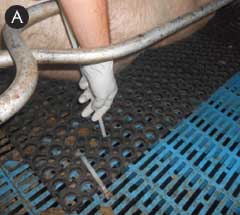
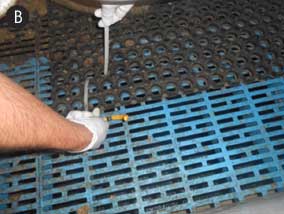
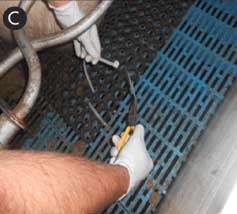
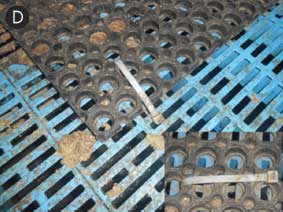
The balance between selecting a mat with perforations that prevent manure accumulation and still providing a comfortable resting surface may be hard to determine. For this production tool, the 1.4-cm perforation size worked sufficiently in allowing accumulated manure to pass through the mat. However, manure build-up may still be a concern for farrowing-lactation stalls where sows can turn 180° and control over placement of the manure deposit is lost.
Implications
• Perforated rubber mats may provide an easy and inexpensive way to improve sow comfort in farrowing stalls.
• Mat size, cleanliness, cost, durability, and management are important factors to consider.
• Rubber mats need to be placed properly under the sow and fastened securely to ensure maximum sow benefit.
Conflict of interest
None reported.
Disclaimer
Scientific manuscripts published in the Journal of Swine Health and Production are peer reviewed. However, information on medications, feed, and management techniques may be specific to the research or commercial situation presented in the manuscript. It is the responsibility of the reader to use information responsibly and in accordance with the rules and regulations governing research or the practice of veterinary medicine in their country or region.
References
1. Pluym LM, Van Nuffel A, Van Weyenberg S, Maes D. Prevalence of lameness and claw lesions during different stages in the reproductive cycle of sows and the impact on reproduction results. Animal. 2013;7:1174–1181.
2. Anil SS, Anil L, Deen J. Effect of lameness on sow longevity. JAVMA. 2009;235:734–738.
3. Barnett JL, Hemsworth PH, Cronin GM, Jongman EC, Hutson GD. A review of the welfare issues for sows and piglets in relation to housing. Aust J Agric Res. 2001;52:1–28.
4. KilBride AL, Gillman CE, Green LE. A cross-sectional study of the prevalence of lameness in finishing pigs, gilts, and pregnant sows and associations with limb lesions and floor types on commercial farms in England. Animal Welfare. 2009;10:215–224.
5. Wells GAH. Locomotor disorders of the pig. In Pract. 1984;6:43–53.
6. Smith B. Lameness in pigs associated with foot and limb disorders. In Pract. 1988;10:113–117.
7. Main DCJ, Clegg J, Spatz A, Green LE. Repeatability of a lameness scoring system for finishing pigs. Vet Record. 2000;147:574–576.
8. Elmore MRP, Garner JP, Johnson AK, Richert B, Pajor ED. A flooring comparison: The impact of rubber mats on the health, behaviour, and welfare of group-housed sows at breeding. Appl Anim Behav Sci. 2010;123:7–15.
9. Calderón-Diaz JA, Fahey AG, KilBride AL, Green LE, Boyle LA. Longitudinal study of the effect of rubber slat mats on locomotory ability, body, limb and claw lesions, and dirtiness of group-housed sows. J Anim Sci. 2014;91:3940–3954.
10. Calderón-Díaz JA, Boyle LA. Effect of housing on rubber slat mats during pregnancy on the behaviour and welfare of sows in farrowing crates. Irish J Agr Food Res. 2014;53:189–197.
*11. Deen J. Effect of a softer floor surface in the farrowing crate on the expression of lameness and subsequent sow performance. NPB#08-153. National Pork Board Animal Research Report. 2010. Available at http://old.pork.org/filelibrary/researchdocuments/08-153-deen--uofmn.pdf. Accessed 1 February 2016.
12. Zurbrigg K. Sow shoulder lesions: Risk factors and treatment effects on an Ontario farm. J Anim Sci. 2006;84:2509–2514.
*13. Kaiser M, Kristensen CS, Bækbo P, Alban L. Treatment of shoulder ulcers in sows – rubber mats and zinc ointment compared to chlortetracycline spray [abstract]. Acta Veterinaria Scandinavica. 2013;55:12.
14. Gravås J. Behavioural and physical effects of floor in piglets and sows. Appl Anim Ethol. 1979;33–45.
15. Boyle LA, Regan D, Leonard FC, Lynch PB, Brophy P. The effect of mats on the welfare of sows and piglets in the farrowing house. Animal Welfare. 2000;9:39–48.
16. Schubbert A, Hartung E, Schrader L. Pressure load on specific body areas of gestating sows lying on rubber mats with different softness. J Anim Sci. 2010;92:3537–3542.
17. Widowski TM, Curtis SE. The influence of straw, cloth tassel, or both on the prepartum behavior of sows. Appl Anim Behav Sci. 1990;27:53–71.
18. Widowski TM, Curtis SE, Dziuk PJ, Wagner WC, Sherwood OD. Behavioral and endocrine responses of sows to prostaglandin F2 alpha and cloprostenol. Biol Reprod. 1990;43:290–297.
19. Grandjot G. Claw problems cost money. SUS-Schewinezucht und Schweinesmast [Swine breeding and swine production]. Munster-Hiltrup, Germany: Landwirtschaftsverlag Agricultural Publishing Company, GmbH. 2007;5:28–31.
*20. Rosendal T, Nielsen JP. Risk factors for the development of decubital ulcers over the scapula of sows. Proc AASV. Toronto, Ontario. 2005:361–362.
* Non-refereed references.
